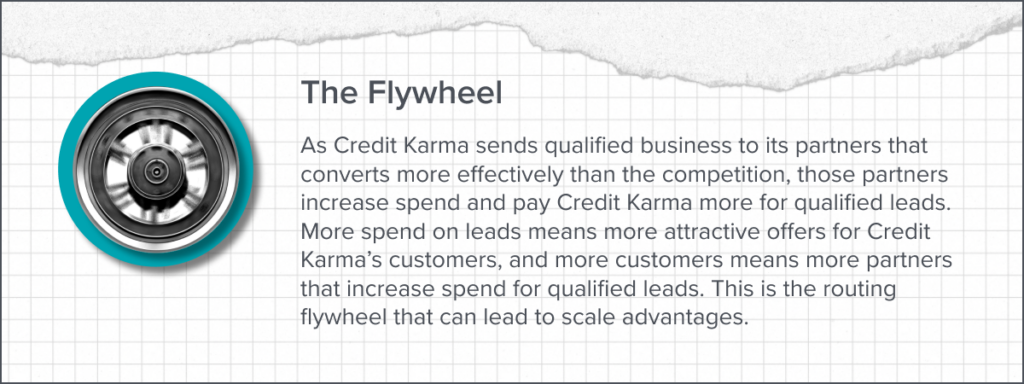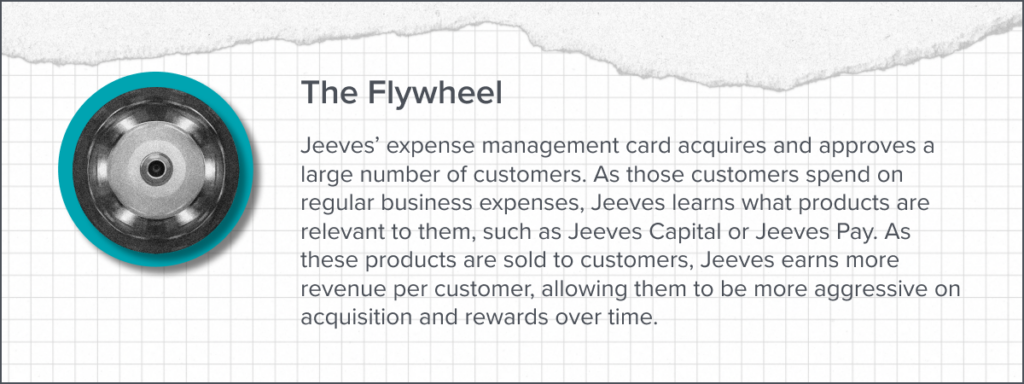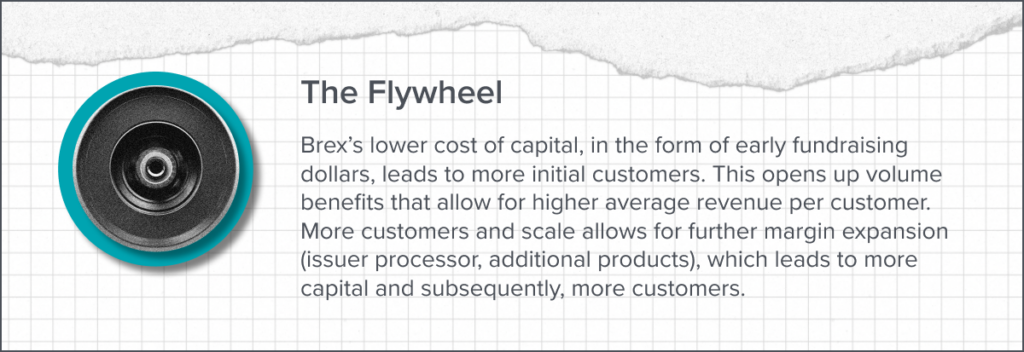Imagine you are the founder of a fintech company that’s identified a massive broken market. As I’ve previously written about, to build your product and identify potential market opportunities, you’ve likely begun buying growth through paid acquisition channels. That was successful, and now your company has started to scale. If you’ve adhered to the rule of finding budgeted customer acquisition channels, you’ve moved a portion—or, better yet, all—of your business into this distribution model. Success! Or is it?
Unfortunately, it’s a bit more complicated than that. Noninflationary acquisition channels only address the most obvious challenge for most fintech companies—growth—but ignore a key factor: differentiation. Differentiation is what ultimately distinguishes one product or service from another, and sustainable differentiation is differentiation combined with some sort of moat. Absent sustainable differentiation, even the most attractive channels (inefficient or budgeted) someday tap out, and Hell’s Flywheel starts spinning anew.
This post is a deep dive into the sustainable differentiation that results in a compounding flywheel, with a focus on financial services companies that sell commodity-like, nonphysical world products such as money, insurance, lending, or equity capital. While not exhaustive, it will cover case studies on how some companies have created business models with higher conversion rates, lower costs of capital, and better cost structures than their incumbent competitors.
But first, why is building a durable advantage unique for financial services companies?
Financial services products are inherently challenging to differentiate because they are usually either non-real, commodity-risk exchanges or exchanges of literal currency (a dollar will always be a dollar, no matter how you use it). Financial services products, and the ability to innovate on such products, are also tightly regulated by the government. These commodity-like features are why personal lines insurance companies (which are exchanges-of-risk businesses) are some of the largest advertisers in the U.S. They need to build their own brands because consumers generally don’t care if GEICO or Progressive pays their insurance claims; they just care that someone pays it.
So, assuming we’re selling commodity products, and that every channel eventually sees a deterioration in advertising efficiency, how does one build a massive business? Enduring, venture-scale businesses are nearly always created with sustainable distribution strategies and product differentiation that lead to a compounding flywheel. Without a flywheel, one can build a profitable business, but probably not a venture-scale one.
But the process of building a compounding flywheel can change based on the funding environment. During the low interest rate period from 2016 to 2022, startups generally followed a playbook around fundraising fast and often to scale through the hard initial stages of a flywheel to engage scale economies. Today, this aggressive fundraising playbook is nearly impossible to run, as investors have reprioritized early unit economic success. Entrepreneurs should view the following case studies as helpful frameworks and examples, but also consider the funding environment they are operating in and whether the case study matches the time in which they are building.
Now, onto the three frameworks—better yet, three “stairways to heaven”—to transform your company that’s headed for Hell’s Flywheel into a Bat Out of Hell.
TABLE OF CONTENTS
Stairway One: Higher Conversion Rates
TABLE OF CONTENTS
The first lever many early stage companies start to pull when their marketing channels become less efficient or paybacks become unattractive is the conversion rate lever. “We’re already acquiring these users!” you may think. “Why don’t we just accept more of the people we’re acquiring?” If you’re having this conversation internally, please read the next section carefully.
What sets financial services businesses apart from other businesses is that, in many cases, they must underwrite some underlying risk as a part of their day-to-day transactions. For example, insurance companies must consider how likely it is for customers to file a claim; payments companies must consider the probability of fraud; and lending companies must consider the probability of customers defaulting. Unlike a consumer business that sells razor blades or hair loss medication, a financial services business might not know how bad the underwriting on risks on their products is until their customer cohorts have sufficiently matured—a concept known as stochastic margins. If a company’s losses are worse than modeled, so is their profitability. This hurts margins, investor returns, and potentially the business’s ability to continue operating. This concept of stochastic margins is also why influencing conversion rates by simply accepting more risk is so challenging. But, if done properly, accepting more risk can lead to a higher expected value per lead, so what should you do? I’ve seen three examples of solving this problem: routing, more lenient underwriting, and contextual conversion driven by high approval commodity products.
Routing
Routing is a business’s ability to properly identify types of risk in onboarding and effectively send that risk to a party that can serve it. Let’s take Credit Karma as an example. When a user visits Credit Karma, they answer a series of questions about themselves so Credit Karma’s systems can properly understand and qualify the lead from a risk perspective. While they are not the end financial services provider, Credit Karma is mapping their potential customers’ risk characteristics across the extremely wide-ranging partners and products it has access to. By only sending qualified leads to its partners, Credit Karma can lower effective acquisition costs as these leads will convert better in the underwriting process.
More lenient underwriting
More lenient (but profitable!) underwriting is a business’s ability to serve certain risks that competitors may view as unprofitable or impossible to understand. A good example of this is cyber insurance. The entire cyber insurance industry has run at over a 100% (unprofitable) loss ratio for the past several years, as carriers have lacked the proper tooling to understand cyber risk, while companies of all sizes have lacked the tooling to mitigate cyber risk. Enter Coalition. Coalition has built proprietary security software that allows it to better understand and mitigate cyber risk. The company calls this “active insurance,” and it enables businesses to serve customers that incumbent carriers would deem too risky or unprofitable. This allows the company, in the segments it serves, to have a higher value per lead versus any incumbent.
Contextual conversion driven by high-approval commodity products
Contextual conversion is a business’s ability to offer a product or service in the right place at the right time. Generally, a business might use a high-approval commodity product, such as company expense cards, to create an initial relationship with a prospective customer, with an eye toward eventually converting that customer to a higher-value, differentiated product at a later time. This is different from the B2B or B2B2C motions I describe in Hell’s Flywheel, in that these companies are offering both the first and second products. The first product is used to create a trusted relationship with insight into the needs and risk profile of a customer, while the second product is built around those unique needs and wants. A good example of this is Jeeves.
Jeeves is an all-in-one financial stack for growing global businesses. The company offers a suite of products and services, but is perhaps best known for its corporate expense card offering. Now Jeeves is hardly the first company to offer expense management programs. However, their spend card is built to have a very high customer approval rate, allowing them to build a large initial customer set. From there, Jeeves can better understand the financial profile of a business using their card, and their day-to-day relationship with the company allows Jeeves to offer them other relevant products at opportune times, like Jeeves Capital, its lending product, or Jeeves Pay, its bill payment solution.
TABLE OF CONTENTS
Stairway Two: Lower cost of capital
TABLE OF CONTENTS
Another way a startup might consider batting out of Hell would be to find a lower cost of capital. Unfortunately, startups are unlikely to have lower costs of capital than large insurers, lenders, or banks. So how does one build in a lower cost of capital as a startup?
Delivering value without actually taking risk
A lower cost of capital is generally only possible through incredible scale. It’s one of the great barriers to entry that large financial institutions enjoy. As a startup lacks comparable scale, any startup that wants to start lending, insuring, or facilitating payments ultimately has to partner with an entity that has low capital costs. There is definitely a short-term marginal benefit to being a better negotiator or more informed partner when working to identify a partner of this type—it’s not a certainty, but it’s highly likely a company gets a better price on a warehouse facility if there are multiple bidders for its business instead of just one. But there are more sustainable models, like creating a closed network through software.
Take Chime, which pivoted into its current business as a down-market neobank around 2016. Their eureka product feature was offering to give their customers their paycheck early, a move that could have incurred major capital costs: users were growing rapidly, and advancing an entire paycheck for multiple days could start to require more of its balance sheet and larger facilities over time. However, Chime forced their customers to put their direct deposits into Chime accounts. This kept the money inside its ecosystem, as they only had to loan the money if a customer spent it—which they rarely did. By creating a closed ecosystem, the salary advances that looked like loans weren’t actually loans at all, and Chime was able to have a lower cost of capital than their competitors and essentially give these salary advances away for free.
Interestingly, this rapid scaling through a lower cost of capital also created enough volume to unlock a second economies of scale flywheel in the form of better rates from banking and card network partners. As more Chime customers spent more money on cards, Visa and BanCorp reduced variable operating costs for Chime, further building its cost of capital advantage over any other neobank.
Lower cost of fundraising / Fundraising scale:
Another spin on a lower cost of capital is being able to fundraise more effectively than the competition. As I wrote earlier in this post, the feasibility of this strategy is fairly dependent on the market dynamics a founder is building in, but given its prevalence over the past several years it’s worth addressing. Achieving a lower cost of capital through fundraising scale describes when a founder is able to raise large quantities of capital before a flywheel has been engaged. This capital is typically raised around the strategy of reaching large enough volume to engage scale economies in low-margin businesses or network effects.
Brex, the spend management business, is a well-known example of a business that better leveraged fundraising as a lower cost of capital than its competition. After completing Y Combinator’s accelerator program in 2017, Brex quickly raised $56.6 million in Series A and B funding. This capital allowed Brex to spend more aggressively on advertising and customer acquisition to get better volume deals from payment processor partners. Much like Chime leveraged “lending without lending,” more customers helped Brex have better early revenue per customer as gross interchange rates were higher.
In addition to the initial volume-driven benefits, Brex also leveraged effective fundraising to vertically integrate and become an issuer processor. This is an expensive and operationally intensive process that is not financially possible for most startups, and now provides Brex with an advantage over some of its competitors, who must now also vertically integrate and become issuer processors to earn comparable interchange rates. In the meantime, Brex can launch additional products to further increase revenue per customer and build a larger moat, all downstream from their initial fundraising success.
TABLE OF CONTENTS
Stairway Three: Lower operating cost structure
TABLE OF CONTENTS
While a lower cost of capital addresses certain aspects of a better cost structure versus an incumbent, there are other ways a financial services business might achieve a sustainably superior cost structure versus an incumbent. Generally, these opportunities involve a startup identifying an area within incumbent competitors where there is high spend on staffing costs for manual tasks. Below are some ways a startup might do this; all of these methods involve deeply understanding the components of an incumbent’s cost structure and counter-positioning.
Streamlining processes
There are countless ways a company might improve operating margins by leveraging technology, especially LLMs. The key to building a sustainable advantage and truly escaping Hell’s Flywheel is whether or not the processes that are being streamlined are easily replicable by either an incumbent or another startup competitor. Many incumbents have been leveraging AI and ML to improve decision-making processes over the past decade. Startups looking to innovate here need to identify areas where the innovation can truly be proprietary. As a historic example, let’s consider Newfront Insurance.
Newfront is a $2+ billion technology-enabled commercial insurance brokerage. The business is built on the premise that, by leveraging technology, an insurance agent can be more productive. This comes down to how a broker might quote and bind a policy, but also how Newfront services existing clients. Proprietary back-office software enables Newfront’s brokers to sell to and service more clients than their competitors. This cost structure advantage powers higher possible payments to their brokers and a better steady-stage profit margin for Newfront.
Building a Generic: Counter Positioning on Marketing
Because they sell commodities, nearly all large companies in financial services spend aggressively on marketing and brand initiatives. Financial services ad spend is nearly 13% of total U.S. ad spend, representing roughly $21 billion in 2020. While this is simply the cost of doing business for incumbents, startups can actually lower their per-unit acquisition costs if they can identify a way to sell their product in a brand-less fashion. This is fairly rare in financial services, and the best-known example is likely Vanguard’s steady ascension into a mutual fund mammoth. A less well-known example is what Clearcover has done for auto insurance.
Clearcover is an auto insurance carrier that offers its products primarily through channels where another party has already acquired the customer. Clearcover’s strategy is to spend as little as possible on branding and marketing, lowering its customer acquisition cost on a unit basis. The business then prices as affordably as possible for its customers, and effectively passes the savings it creates by not spending on marketing back onto the customer. As other large incumbents market directly or maintain large agent sales forces, it would be very challenging for them to decrease brand spending. It would also destroy the branding moat they enjoy.
TABLE OF CONTENTS
Paradise
TABLE OF CONTENTS
Leveraging these stairways to become a bat out of Hell can lead to “everlasting life”—a sustainable, competitive advantage. Though circling one or more of the aspects of differentiation described above and incorporating it into a business might seem challenging, hopefully learning how other companies have navigated the journey will provide you with a blueprint to successfully follow.
* * *
The views expressed here are those of the individual AH Capital Management, L.L.C. (“a16z”) personnel quoted and are not the views of a16z or its affiliates. Certain information contained in here has been obtained from third-party sources, including from portfolio companies of funds managed by a16z. While taken from sources believed to be reliable, a16z has not independently verified such information and makes no representations about the enduring accuracy of the information or its appropriateness for a given situation. In addition, this content may include third-party advertisements; a16z has not reviewed such advertisements and does not endorse any advertising content contained therein.
This content is provided for informational purposes only, and should not be relied upon as legal, business, investment, or tax advice. You should consult your own advisers as to those matters. References to any securities or digital assets are for illustrative purposes only, and do not constitute an investment recommendation or offer to provide investment advisory services. Furthermore, this content is not directed at nor intended for use by any investors or prospective investors, and may not under any circumstances be relied upon when making a decision to invest in any fund managed by a16z. (An offering to invest in an a16z fund will be made only by the private placement memorandum, subscription agreement, and other relevant documentation of any such fund and should be read in their entirety.) Any investments or portfolio companies mentioned, referred to, or described are not representative of all investments in vehicles managed by a16z, and there can be no assurance that the investments will be profitable or that other investments made in the future will have similar characteristics or results. A list of investments made by funds managed by Andreessen Horowitz (excluding investments for which the issuer has not provided permission for a16z to disclose publicly as well as unannounced investments in publicly traded digital assets) is available at https://a16z.com/investments/.
Charts and graphs provided within are for informational purposes solely and should not be relied upon when making any investment decision. Past performance is not indicative of future results. The content speaks only as of the date indicated. Any projections, estimates, forecasts, targets, prospects, and/or opinions expressed in these materials are subject to change without notice and may differ or be contrary to opinions expressed by others. Please see https://a16z.com/disclosures for additional important information.









